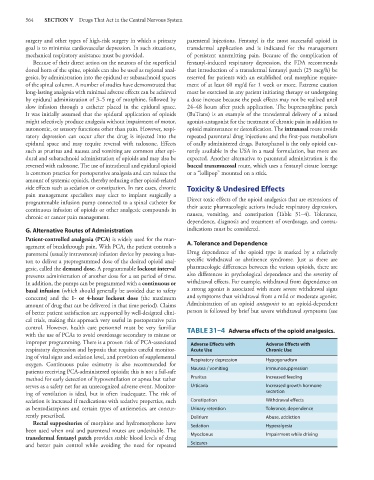Page 578 - Basic _ Clinical Pharmacology ( PDFDrive )
P. 578
564 SECTION V Drugs That Act in the Central Nervous System
surgery and other types of high-risk surgery in which a primary parenteral injections. Fentanyl is the most successful opioid in
goal is to minimize cardiovascular depression. In such situations, transdermal application and is indicated for the management
mechanical respiratory assistance must be provided. of persistent unremitting pain. Because of the complication of
Because of their direct action on the neurons of the superficial fentanyl-induced respiratory depression, the FDA recommends
dorsal horn of the spine, opioids can also be used as regional anal- that introduction of a transdermal fentanyl patch (25 mcg/h) be
gesics, by administration into the epidural or subarachnoid spaces reserved for patients with an established oral morphine require-
of the spinal column. A number of studies have demonstrated that ment of at least 60 mg/d for 1 week or more. Extreme caution
long-lasting analgesia with minimal adverse effects can be achieved must be exercised in any patient initiating therapy or undergoing
by epidural administration of 3–5 mg of morphine, followed by a dose increase because the peak effects may not be realized until
slow infusion through a catheter placed in the epidural space. 24–48 hours after patch application. The buprenorphine patch
It was initially assumed that the epidural application of opioids (BuTrans) is an example of the transdermal delivery of a mixed
might selectively produce analgesia without impairment of motor, agonist-antagonist for the treatment of chronic pain in addition to
autonomic, or sensory functions other than pain. However, respi- opioid maintenance or detoxification. The intranasal route avoids
ratory depression can occur after the drug is injected into the repeated parenteral drug injections and the first-pass metabolism
epidural space and may require reversal with naloxone. Effects of orally administered drugs. Butorphanol is the only opioid cur-
such as pruritus and nausea and vomiting are common after epi- rently available in the USA in a nasal formulation, but more are
dural and subarachnoid administration of opioids and may also be expected. Another alternative to parenteral administration is the
reversed with naloxone. The use of intrathecal and epidural opioid buccal transmucosal route, which uses a fentanyl citrate lozenge
is common practice for postoperative analgesia and can reduce the or a “lollipop” mounted on a stick.
amount of systemic opioids, thereby reducing other opioid-related
side effects such as sedation or constipation. In rare cases, chronic Toxicity & Undesired Effects
pain management specialists may elect to implant surgically a
programmable infusion pump connected to a spinal catheter for Direct toxic effects of the opioid analgesics that are extensions of
continuous infusion of opioids or other analgesic compounds in their acute pharmacologic actions include respiratory depression,
chronic or cancer pain management. nausea, vomiting, and constipation (Table 31–4). Tolerance,
dependence, diagnosis and treatment of overdosage, and contra-
G. Alternative Routes of Administration indications must be considered.
Patient-controlled analgesia (PCA) is widely used for the man-
agement of breakthrough pain. With PCA, the patient controls a A. Tolerance and Dependence
parenteral (usually intravenous) infusion device by pressing a but- Drug dependence of the opioid type is marked by a relatively
ton to deliver a preprogrammed dose of the desired opioid anal- specific withdrawal or abstinence syndrome. Just as there are
gesic, called the demand dose. A programmable lockout interval pharmacologic differences between the various opioids, there are
prevents administration of another dose for a set period of time. also differences in psychological dependence and the severity of
In addition, the pumps can be programmed with a continuous or withdrawal effects. For example, withdrawal from dependence on
basal infusion (which should generally be avoided due to safety a strong agonist is associated with more severe withdrawal signs
concerns) and the 1- or 4-hour lockout dose (the maximum and symptoms than withdrawal from a mild or moderate agonist.
amount of drug that can be delivered in that time period). Claims Administration of an opioid antagonist to an opioid-dependent
of better patient satisfaction are supported by well-designed clini- person is followed by brief but severe withdrawal symptoms (see
cal trials, making this approach very useful in postoperative pain
control. However, health care personnel must be very familiar TABLE 31–4 Adverse effects of the opioid analgesics.
with the use of PCAs to avoid overdosage secondary to misuse or
improper programming. There is a proven risk of PCA-associated Adverse Effects with Adverse Effects with
respiratory depression and hypoxia that requires careful monitor- Acute Use Chronic Use
ing of vital signs and sedation level, and provision of supplemental Respiratory depression Hypogonadism
oxygen. Continuous pulse oximetry is also recommended for
patients receiving PCA-administered opioids; this is not a fail-safe Nausea / vomiting Immunosuppression
method for early detection of hypoventilation or apnea but rather Pruritus Increased feeding
serves as a safety net for an unrecognized adverse event. Monitor- Urticaria Increased growth hormone
ing of ventilation is ideal, but is often inadequate. The risk of secretion
sedation is increased if medications with sedative properties, such Constipation Withdrawal effects
as benzodiazepines and certain types of antiemetics, are concur- Urinary retention Tolerance, dependence
rently prescribed. Delirium Abuse, addiction
Rectal suppositories of morphine and hydromorphone have Sedation Hyperalgesia
been used when oral and parenteral routes are undesirable. The
transdermal fentanyl patch provides stable blood levels of drug Myoclonus Impairment while driving
and better pain control while avoiding the need for repeated Seizures

